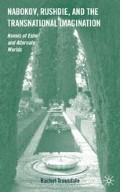Abstract
While The Ground Beneath Her Feet (1999) opens with a nostalgic description of the 1950s Bombay pluralism central to Midnight’s Children, The Satanic Verses, and The Moor’s Last Sigh, it is in the end an American novel, doing for America what Midnight’s Children does for India. In what Anshuman Mondal describes as “a profound ideological shift,” The Ground Beneath Her Feet is centered not in Bombay but in New York, and rock music, the dominant art form of the book, is treated as both a global and a specifically American phenomenon.1 Rushdie himself describes it as “my first American novel.”2 Like his Indian novels, however, The Ground Beneath Her Feet makes the pluralist city stand in for the nation, suggesting that pluralism is essential to American identity and treating New York-style multiculturalism as the next iteration in Rushdie’s ongoing examination of rooted cosmopolitanisms.
Access this chapter
Tax calculation will be finalised at checkout
Purchases are for personal use only
Preview
Unable to display preview. Download preview PDF.
Notes
Anshuman A. Mondal, “The Ground Beneath Her Feet and Fury: The Reinvention of Location,” in The Cambridge Companion to Salman Rushdie, ed. Abdulrazak Gurnah (Cambridge: Cambridge University Press, 2007), 169.
Elena Rossi argues that Rushdie’s “ironic lowering” of myth replaces gods with art; Elena Rossi, “‘Against an amnesiac culture’: Greek and Latin Mythology in The Ground Beneath Her Feet,” in The Great Wo r k of Making Real: Salman Rushdie’s The Ground Beneath Her Feet, ed. Elsa Linguanti and Viktoria Tchernichova (Pisa: Edizioni ETS, 2003). Shaul Bassi treats Orpheus as a colonial agent; Shaul Bassi, “Orpheus’s Other Voyage: Myth, Music, and Globalisation,” in The Great Work of Making Real: Salman Rushdie’s The Ground Beneath Her Feet, ed. Elsa Linguanti and Viktoria Tchernichova (Pisa: Edizioni ETS, 2003). See also Alessandro Monti, “A Hoarding of Goats and Rumours of Mermaids: Puzzling out Myth in The Ground Beneath Her Feet,” in The Great Work of Making Real: Salman Rushdie’s The Ground Beneath Her Feet, ed. Elsa Linguanti and Viktoria Tchernichova (Pisa: Edizioni ETS, 2003); Sylvia Albertazzi, “‘Why do we care about singers?’ Music in The Ground Beneath Her Feet,” in The Great Work of Making Real: Salman Rushdie’s The Ground Beneath Her Feet, ed. Elsa Linguanti and Viktoria Tchernichova (Pisa: Edizioni ETS, 2003).
Elsa Linguanti argues that Maria represents Ormus’s abandoned possibilities and the destruction of her world condemns the violence of our own. Elsa Linguanti, “Different Whatnesses,” in The Great Work of Making Real: Salman Rushdie’s The Ground Beneath Her Feet, ed. Elsa Linguanti and Viktoria Tchernichova (Pisa: Edizioni ETS, 2003).
Viktoria Tchernichova, “‘The solutions to the problems of art are always technical’: Some Observations on Textual Topologies,” in The Great Work of Making Real: Salman Rushdie’s The Ground Beneath Her Feet, ed. Elsa Linguanti and Viktoria Tchernichova (Pisa: Edizioni ETS, 2003), 167.
Gary Saul Morson and Caryl Emerson, “Bakhtin,” in The Johns Hopkins Guide to Literary Theory and Criticism, ed. Michael Groden and Martin Kreiswirth (Baltimore: Johns Hopkins University Press, 1994), 67.
Fausto Ciomi, “Wor(l)d-shifts, Functions, Dialogue in The Ground Beneath Her Feet: More Skirmishes in the War of Meanings,” in The Great Work of Making Real: Salman Rushdie’s The Ground Beneath Her Feet, ed. Elsa Linguanti and Viktoria Tchernichova (Pisa: Edizioni ETS, 2003), 220.
Pierre Bayle, Historical and Critical Dictionary, trans. Richard H. Popkin and Craig Bush (Indianapolis, IN: Bobbs-Merrill, 1965), 145.
Roger Manvell and Lewis Jacobs, The International Encyclopedia of Film (New York: Bonanza, 1975), 150.
Ibid. As Tchernichova argues, Rai’s literalism opposes Ormus’s asceticism: the alternative to renunciation is to “acknowledge the world as it is, with all its horrors, and thus acquire a Dionysian or tragic vision of life.” Viktoria Tchernichova, “‘The outsideness of what we’re inside’: Double Vision as Künstlerästhetik in The Ground Beneath Her Feet,” in The Great Work of Making Real: Salman Rushdie’s The Ground Beneath Her Feet, ed. Elsa Linguanti and Viktoria Tchernichova (Pisa: Edizioni ETS, 2003), 84.
See also Carmen Concilio, “‘Worthy of the world’: The Narrator/Photographer in Salman Rushdie’s The Ground Beneath Her Feet,” in The Great Work of Making Real: Salman Rushdie’s The Ground Beneath Her Feet, ed. Elsa Linguanti and Viktoria Tchernichova (Pisa: Edizioni ETS, 2003).
Judith Leggatt, “Other Worlds, Other Selves: Science Fiction in Salman Rushdie’s The Ground Beneath Her Feet,” ARIEL 33, no. 1 (2002): 123.
J. R. R. Tolkien, The Return of the King (New York: Ballantine Books, 1972), 385.
Randy Boyagoda, “‘Three Kings of Disorient’: A Globalized Search for Home in The Ground Beneath Her Feet,” South Asian Review 24, no. 1 (2003): 131.
Klaus Stierstorfer, “Wobbly Grounds: Postmodernism’s Precarious Footholds in Novels by Malcolm Bradbury, David Parker, Salman Rushdie, Graham Swift,” in Beyond Postmodernism: Reassessments in Literature, Theory, and Culture, ed. Klaus Stiersorfer (New York: Walter de Gruyter, 2003), 220.
Copyright information
© 2010 Rachel Trousdale
About this chapter
Cite this chapter
Trousdale, R. (2010). What Actually Happens. In: Nabokov, Rushdie, and the Transnational Imagination. Palgrave Macmillan, New York. https://doi.org/10.1057/9780230106888_7
Download citation
DOI: https://doi.org/10.1057/9780230106888_7
Publisher Name: Palgrave Macmillan, New York
Print ISBN: 978-1-349-28697-3
Online ISBN: 978-0-230-10688-8
eBook Packages: Palgrave Literature CollectionLiterature, Cultural and Media Studies (R0)

